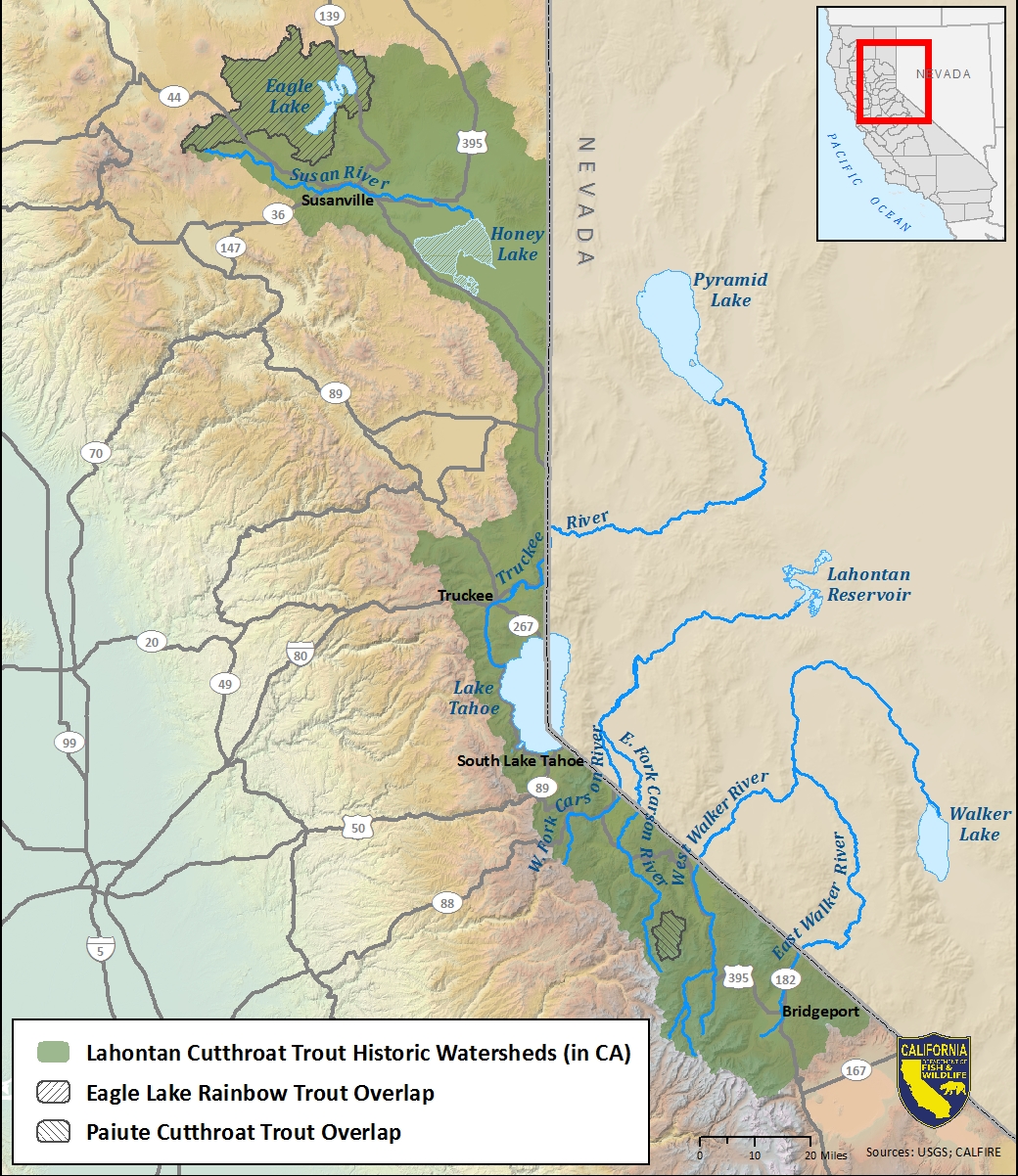Identification
Well-adapted to both lake and stream environments, Lahontan cutthroat trout may look different depending on where you catch them.
Lake-form
 Lake-form Lahontan cutthroat trout.
Lake-form Lahontan cutthroat trout.
- Tend to be larger, with a squared tail to chase prey and avoid predators.
- Coloration green to greenish-brown on the back, faint yellow with a pink lateral band on the sides, and silver to white on the belly.
- Parr marks disappear in mature fish.
- Spawning trout can be vibrant copper, red, and orange, especially males.
- Large, almost ink-black rounded spots sparsely dot the body, with fewer below the lateral line.
- Like other cutthroat trout, they have a distinguishing red to orange slash mark at the throat, but it can be pale on lake forms.
Stream-resident
 Stream-resident Lahontan cutthroat trout.
Stream-resident Lahontan cutthroat trout.
- Same faint rosy-pink band along the lateral line and cutthroat slashes.
- Darker coloration dominated by copper to green hues, numerous body spots, and the retention of parr marks into adulthood.
- The sides are copper or lemon-yellow in color, fading into a white belly and olive-copper back.
- Parr marks tend to occur in numerous rows, or sub-rows, of increasingly smaller size.
- Often, five dark halos rim the iris of the eye.
- Owing to restricted distribution in the headwaters of their range, they tend to be small in size; however, those caught in streams can be vibrantly colored and heavily-spotted, making them a unique catch.
Distribution
- Range extends from the Sierra Nevada Mountains northeast into Nevada and Oregon.
- In California, the historic range includes Lake Tahoe and the Carson, Truckee, and Walker River basins. Reports from settlers in 1853 assert Lahontan cutthroat trout were abundant in the Susan River as well.
- Once occupied a vast range but are extirpated from nearly 95% of their native habitat in California.
- Inhabit a wide range of habitats from high-elevation mountain streams to lower-elevation and highly alkaline desert lakes.
Introduction of non-native trout and habitat alteration from human land use activities caused their extirpation from the majority of their former range. Most self-sustaining populations are located in isolated headwater streams and are the result of reintroduction efforts. State fish hatcheries have been increasing their production and stocking of Lahontan cutthroat trout to expand fishing opportunities for this species in accessible waters within their native drainage.

Angling
Lake-form
 Heenan Lake.
Heenan Lake.
- Feed on fish, insects, and scuds.
- Target areas of structure (submerged rocks, woody debris, or drop-offs).
- Try a variety of streamers, nymphs, lures, or other subsurface patterns on an intermediate sink tip line with a very slow retrieval.
- It's important to get your terminal tackle to the same water depth as the trout.
At Heenan Lake, anglers typically use one of three techniques:
- Nymph fishing with an intermediate sink line and a small beaded nymph (prince nymph, hare’s ear, or bird’s nest).
- Indicator fishing with multiple midges or scuds, suspended at varying depths in the water column.
- Trolling: gold-colored cast masters and Thomas buoyant spinning lures are very popular.
Stream-resident
 Upper Truckee River.
Upper Truckee River.
- Typically feed on drifting terrestrial or aquatic insects.
- Prefer slower water and pools.
- Are opportunistic feeders and tend to eat whatever is most abundant on a seasonal basis.
- A wide variety of dry flies and standard nymph patterns are effective (or combinations thereof), such as the “hopper-dropper” technique.
- Terrestrial patterns including beetles, ants, and grasshoppers are often quite effective.
- In streams, they prefer slower water; target areas with good cover like undercut banks, overhanging vegetation, or woody debris.